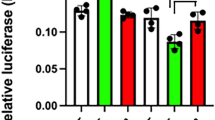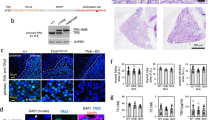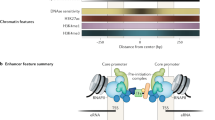Abstract
THE specific expression of growth hormone (GH) in the somatotrophic cells of the anterior pituitary is largely attributable to a short promoter in the 5' flanking region of the GH gene1–6. This promoter contains two binding sites for the transcription factor GHF-1 (refs 3,7), the expression of which is also specific to cells of the somatotrophic lineage8,9 and correlates with activation of the GH gene in the developing mouse pituitary9. Various studies indicate that GHF-1 is the main determinant of cell type-specific expression of the GH gene3–9. GHF-1 is a member of the POU-domain class of proteins that each contain two highly conserved sequence motifs, the homoeodomain and the POU-specific domain8,10,11. Here we report that the GHF-1 homoeodomain is sufficient for sequence-specific DNA binding, although its activity is stimulated by the POU-specific domain, which does not interact directly with the DNA. Transcriptional activation is mediated by a separate domain rich in hydroxylated amino-acid residues. Similar sequences are present in other cell type-specific transcription factors.
This is a preview of subscription content, access via your institution
Access options
Subscribe to this journal
Receive 51 print issues and online access
$199.00 per year
only $3.90 per issue
Buy this article
- Purchase on Springer Link
- Instant access to full article PDF
Prices may be subject to local taxes which are calculated during checkout
Similar content being viewed by others
References
Karin, M. in Tissue Specific Gene Expression (ed. Renkawitz, R.) 137–137 (VCH, Weinheim, 1989).
Miller, W. L. & Eberhardt, N. L. Endocr. Rev. 4, 97–130 (1983).
Lefevre, C. et al. EMBO J. 6, 971–981 (1987).
West, B. L. et al. Molec. cell. Biol 7, 1193–1197 (1987).
Behringer, R. R., Mathews, L. S., Palmiter, R. D. & Brinster, R. L. Genes Dev. 2, 453–461 (1988).
Borrelli, E. et al. Nature 339, 538–541 (1989).
Bodner, M. & Karin, M. Cell 50, 267–275 (1987).
Bodner, M. et al. Cell 55, 505–518 (1988).
Dolle, P. et al. Cell (in the press).
Ingraham, H. A. et al. Cell 55, 519–529 (1988).
Herr, W. et al. Genes Dev. 2, 1513–1516 (1988).
Karin, M. et al. Nature 308, 513–519 (1984).
Castrillo, J.-L., Bodner, M. & Karin, M. Science 243, 814–817 (1989).
Desplan, C., Theis, J. & O'Farrell, P. H. Cell 54, 1081–1090 (1988).
Hoey, T., & Levine, M. Nature 332, 858–861 (1988).
Muller, M. et al. EMBO J. 7, 4299–4304 (1988).
Angel, P., Smeal, T., Meek, J. & Karin, M. New Biol. 1, 35–43 (1989).
Sturm, R. A. & Herr, W. Nature 336, 601–604 (1988).
Ma, J. & Ptashne, M. Cell 51, 113–119 (1987).
Hope, I. A., Mahadevan, S. & Struhl, K. Nature 333, 635–640 (1988).
Ptashne, M. Nature 335, 683–689 (1988).
Angel, P. et al. Nature 332, 166–171 (1988).
Richardson, W. D., Roberts, B. L. & Smith, A. E. Cell. 44, 77–85 (1986).
Courey, A. J. & Tjian, R. Cell 55, 887–898 (1988).
Clerc, R. G. et al. Genes Dev. 2, 1570–1581 (1988).
Muller, M. M., Rupert, S., Schaffner, W. & Matthias, P. Nature 336, 544–551.
Scheidereit, C. et al. Nature 336, 551–557 (1988).
Finney, M., Ruvzun, G. & Horvitz, H. R. Cell 55, 757–769 (1988).
Braun, T. et al. EMBO J. 8, 701–709 (1989).
Allison, L. A., Moyle, M., Shales, M. & Ingles, C. J. Cell 42, 599–610 (1985).
Cisek, L. J. & Corden, J. L. Nature 339, 679–684 (1989).
Sigler, P. S. Nature 333, 210–212 (1988).
Mullis, K. S. & Faloona, F. A. Meth. Enzym. 155, 335–350 (1987).
Hattori, M. & Sakaki, Y. Analyt. Biochem. 152, 232–238 (1986).
Chen, C. & Okayama, H. Molec. cell. Biol. 7, 2745–2752 (1987).
Maxwell, I. H., Harrison, G. S., Wood, W. M. & Maxwell, F. Biotechnology 7, 276–280 (1980).
Author information
Authors and Affiliations
Rights and permissions
About this article
Cite this article
Theill, L., Castrillo, JL., Wu, D. et al. Dissection of functional domains of the pituitary-specific transcription factor GHF-1. Nature 342, 945–948 (1989). https://doi.org/10.1038/342945a0
Received:
Accepted:
Issue Date:
DOI: https://doi.org/10.1038/342945a0
This article is cited by
-
Precocious or early puberty in patients with combined pituitary hormone deficiency due to POU1F1 gene mutation: case report and review of possible mechanisms
Hormones (2018)
-
Combined pituitary hormone deficiency: current and future status
Journal of Endocrinological Investigation (2015)
-
Identification of novel SNPs in the Sarda breed goats POU1F1 gene and their association with milk productive performance
Molecular Biology Reports (2013)
-
Ovis aries POU1F1 Gene: Cloning, Characterization and Polymorphism Analysis
Genetica (2006)
-
Target integration by a chimeric Sp1 zinc finger domain-moloney murine leukemia virus integrase in vivo
Journal of Biomedical Science (2002)
Comments
By submitting a comment you agree to abide by our Terms and Community Guidelines. If you find something abusive or that does not comply with our terms or guidelines please flag it as inappropriate.



